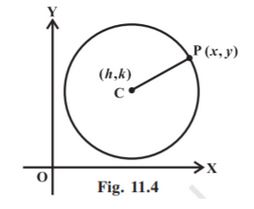Class 11 NCERT Math Notes
Quickly revise all chapters for the year end examination.
Click Here
A circle isn’t just a round sketch. In coordinate geometry, it is a collection of infinite points whose distance from a fixed centre is constant. Put that idea on an xx-yy grid and you can write the circle as a single algebraic sentence:
where (h,k) pins down the centre and r fixes the radius of a circle equation. If the centre happens to be the origin (0,0), the formula trims to
. Learning about this one relationship lets you locate tangents, intersecting chords, and even fit circles through three scattered points. The NCERT exercise of Conic Sections covers questions on this topic for the convenience of students.
Students must be well-versed in the topic since it is important from both school and entrance examination point of view.
Quickly revise all chapters for the year end examination.
Click HereGet ready for a 5-star performance in the CBSE board exams.
Revise NowVerify if you are answering the questions correctly!
Take a LookBe ready for CBSE board exams.
Check NowThe equation of circle is x² + y² + 2gx + 2fy + c = 0, where center of the circle is at point (-g, -f) and radius is given by formula r = √(g² + f² - c).
Let the centre of the circle be at a fixed point C (h, k) and the length of the radius be equal to r. If P(x, y) be the moving point on the circle, we have the definition | CP| = r. Therefore, the equation is:
The simplest form of the equation of a circle is when its centre lies at the origin (0, 0) and the radius is r. In this case, the equation of a circle will be x² + y² = r².
Class 12th students who are going to take CBSE board exams must be well aware of the concept to perform well in the exam.
Some Particular Cases
This is an important topic from Conic Sections, which covers different forms of the equation of a circle. Amongst them, the general form of circle's equation is as follows:

Let us discuss different forms of equation of circle one by one:
Centre = (h, k) and radius = r. If h = k = 0, it reduces to .
Centre = (−g, −f); radius = .
Touches the x-axis at (a, 0) and the y-axis at (0, b). Radius = ½√(a² + b²).
Works because any angle in a semicircle is 90°, so the product of slopes is −1.
Single parameter θ (0 → 2π) traces the whole circle; great for calculus or plotting.
This is the tangent to a circle centred at the origin. (The normal line joins the centre to (x1, y1).)
Changing k changes the radius but keeps the centre fixed at (−g, −f).
1: Equation of the circle whose centre is at ( -5, 4) and the radius is 7 is –
Solution. (x+5)2 + (y-4)2 = 72
i.e., x2+ y2+ 10x - 8y- 8 = 0.
2. Find the centre and the radius of the circle x2 + y2+ 8x + 10y – 8 = 0.
Solution. The given equation is (x2 + 8x) + (y2 + 10y) = 8
Now, completing the squares within the parenthesis,
we get (x2+ 8x + 16) + (y2 + 10y + 25) = 8 + 16 + 25 i.e. (x + 4)2 + (y + 5)2 = 49 i.e. {x – (– 4)}2 + {y – (–5)}2 = 72.
Therefore, the given circle has a centre at (– 4, –5) and radius 7.
Questions based on the steps of the derivation are often asked in entrance exams such as JEE Main and IIT JAM. Here, we will be sharing the step-by-step derivation of circle's equation:
Centre = (h, k), radius = r. If h = k = 0 you get .
Centre = (−g, −f); radius = .
Touches x-axis at (a, 0) and y-axis at (0, b). Radius = ½√(a² + b²).
Valid because any angle in a semicircle is 90°.
One parameter θ sweeps out the entire circle—ideal for calculus or plotting.
This is the tangent to (x − h)² + (y − k)² = r² when the circle is centred at the origin.
Different values of k yield circles with the same centre (−g, −f) but varying radii.
Maths Conic Sections Exam
Exams accepted
CA Foundation
Exams accepted
ICSI Exam
Exams accepted
BHU UET | GLAET | GD Goenka Test
Bachelor of Business Administration & Bachelor of Law
Exams accepted
CLAT | LSAT India | AIBE
Exams accepted
IPMAT | NMIMS - NPAT | SET
Exams accepted
BHU UET | KUK Entrance Exam | JMI Entrance Exam
Bachelor of Design in Animation (BDes)
Exams accepted
UCEED | NIFT Entrance Exam | NID Entrance Exam
BA LLB (Bachelor of Arts + Bachelor of Laws)
Exams accepted
CLAT | AILET | LSAT India
Bachelor of Journalism & Mass Communication (BJMC)
Exams accepted
LUACMAT | SRMHCAT | GD Goenka Test